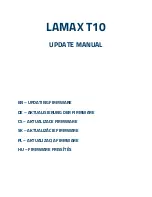
MAIA M2
Quick User Guide
EOPTIS / SAL ENGINEERING
Page 8 of 15
MAIA M2
Rev.1.01 - 07/2019
Copyright © 2016-2019
The choice of the pair of filters for the MAIA M2 camera is usually related to the type of indices to be calculated
according to the type of application. The models offered with the relative obtainable indices are described in Table 2.
Model
Bands
Main indices
Other indices
M2-V01
B1
B5
PPR
Plant Pigment Ratio
CTR6
M2-V02
B1
B8
NPCI
Normalized Pigment Chlorophyll
Index
IO, CTR1, LIC2, SRPI
M2-V03
B1
B11
WV-BI
Worldview Built-Up Index
WV-NHFD
M2-V04
B1
B15
BWDRVI
Blue-Wide Dynamic Range
Vegetation Index
WV-VI
M2-V05
B3
B5
PRI
Photochemical Reflectance
Index
BGI, CRI1
M2-V06
B3
B8
BRI
Blue Red Pigment Index
IOR
M2-V07
B3
B11
CRI2
Carotenoid Reflectance Index 2
M2-V08
B3
B15
BNDVI
Blue Normalized Difference
Vegetation Index
PSSRC1, PSSRC2,
PSNDC1
M2-V09
B5
B8
PVR
Photosynthetic Vigour Ratio
NGRDI, DSWI-4, GI
M2-V10
B5
B11
ARI
Anthocyanin Reflectance Index
M2-V11
B5
B15
GNDVI
Green Normalized Difference
Vegetation Index
PBI, GOSAVI, GSAVI,
RARS, GRVI, GCI
M2-V12
B7
B15
CTR3
Simple Ratio Carter 3
M2-V13
B8
B11
NDVIRedEdge
Normalized Difference
Vegetation Index Red Edge
FR, FR2, CTR4
M2-V14
B8
B15
NDVI
Normalized Difference
Vegetation Index
RDVI, TDVI, WDVI,
WDRVI
M2-V15
B11
B15
NDRE
Normalized Difference Red Edge
Index
NDCHL, RRI
M2-V16
RGB B15
NDVI* GNDVI*
BNDVI* SAVI*
Immagine a
colori
*con Rosso/Verde/Blu a banda
larga
Table 2. MAIA M2 models with realted combinations of bands and multispectral indices.
2.2
E
XPOSURE
The camera works in self-exposure trying to keep the average image value constant at target value despite
environmental variations. To do this, the exposure times are setted independently for each sensor. The exposure target,
common to the two sensors, can be set between three predefined values using the button on the camera. The default
values are 0.15, 0.20 or 0.25, with 0.20 set by default. These values are to be considered as the average brightness of
the image on a scale from 0 to 1, where in 0 there is a completely dark image and in 1 there is a completely saturated
image (all pixels with value 255 if in 8 bits or 1024 if in 12 bit). In the case of 0.20, for example, the average value of the
image will be around 51 codes (8 bits) or 205 codes (12 bits). The image will appear visually underexposed in its entirety
but this allows you to keep information even for any particularly bright areas that should appear in the image, occupying
only a marginal part.
The exposure algorithm requires a certain number of images to converge, depending on scene. In external trigger mode
the images are acquired only in the presence of triggers and therefore the first ones may not be correctly exposed.

































